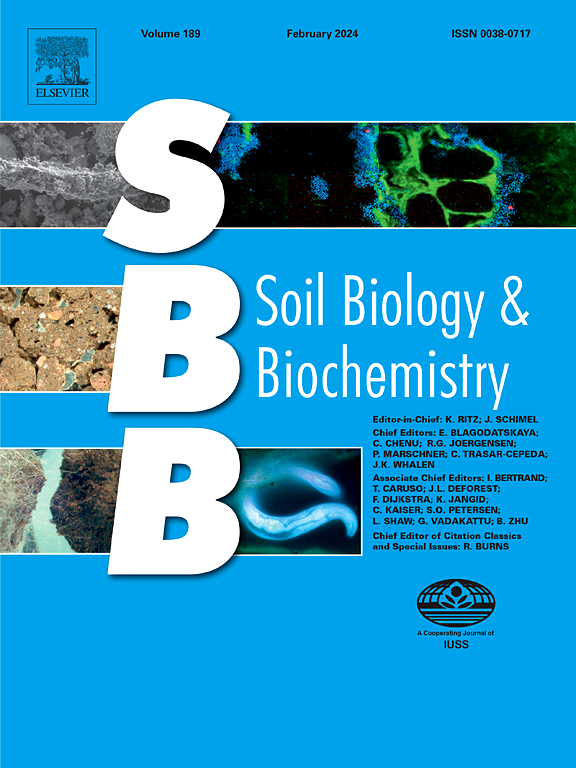早期演替系统支持线虫群落抵抗干旱胁迫
IF 9.8
1区 农林科学
Q1 SOIL SCIENCE
引用次数: 0
摘要
随着气候变化,可变降雨量预计会增加,并将导致更多的干旱压力。在管理方式不同的农业系统中,干旱对线虫抗性的影响尚不清楚。自由生活的线虫对干扰敏感,并且跨越r-K战略连续统,因此可以作为气候胁迫的生物指标。在这里,我们的目标是1)了解管理强度如何影响线虫群落对干旱的抵抗力,2)评估干旱的立即缓解如何影响对比农业生态系统中的线虫群落。本研究利用了W.K. Kellogg生物站长期生态研究试验,在两种土地利用(早期演作和免耕一年生行作物)中诱导了三种降雨操纵(干旱、可变和控制)。线虫群落取样分别在干旱实施前(干旱前)、干旱诱发后6周(干旱高峰)和重新湿润后1天(干旱后)进行。在早期土地利用演替过程中,干旱高峰期线虫群落结构和分布沿r-K战略连续体变化不大。在免耕土地利用中,食真菌和策略线虫的丰度随干旱胁迫而下降,表明总体抗旱性降低。类似的模式在干旱后持续存在,即早期演替土地利用内的线虫保持不变,而免耕土地利用内的线虫响应缓解而转变较慢。这项研究表明,早期的土地演替利用对于培育耐旱的线虫群落是有价值的。此外,干旱胁迫影响线虫群落动态,影响生态系统功能。本文章由计算机程序翻译,如有差异,请以英文原文为准。
Early successional systems support nematode community resistance to drought stress
Variable rainfall is expected to increase with climate change and will lead to more drought stress. The impact of drought on nematode resistance within agricultural systems that vary in management is unknown. Free-living nematodes can serve as bioindicators of climatic stress because they are sensitive to disturbance and span the r-K strategist continuum. Here we aim to 1) understand how management intensity impacts the resistance of nematode communities to drought and 2) assess how the immediate alleviation of drought impacts nematode communities in contrasting agroecosystems. This study utilized the W.K. Kellogg Biological Station Long-Term Ecological Research trial where three rainfall manipulations were induced (drought, variable, and control) in two land uses (an early successional and a no-till annual row-crop). Sampling for nematode communities was conducted prior to drought implementation (pre-drought), six weeks after drought was induced (peak-drought), and one day after re-wetting (post-drought). There was little shift in nematode community structure or distribution along an r-K strategist continuum at peak-drought in the early successional land use. In the no-till land use, fungivore r-strategist nematode abundances declined with drought stress, indicating overall less resistance to drought. Similar patterns persisted post-drought, whereby nematodes within the early successional land use remained unchanged, while nematodes within the no-till land use were slower to shift in response to alleviation. This study demonstrates that early successional land uses are valuable for fostering nematode communities that are resistant to drought. Moreover, drought stress impacts nematode community dynamics, which has implications for ecosystem functioning.
求助全文
通过发布文献求助,成功后即可免费获取论文全文。
去求助
来源期刊

Soil Biology & Biochemistry
农林科学-土壤科学
CiteScore
16.90
自引率
9.30%
发文量
312
审稿时长
49 days
期刊介绍:
Soil Biology & Biochemistry publishes original research articles of international significance focusing on biological processes in soil and their applications to soil and environmental quality. Major topics include the ecology and biochemical processes of soil organisms, their effects on the environment, and interactions with plants. The journal also welcomes state-of-the-art reviews and discussions on contemporary research in soil biology and biochemistry.
 求助内容:
求助内容: 应助结果提醒方式:
应助结果提醒方式:


